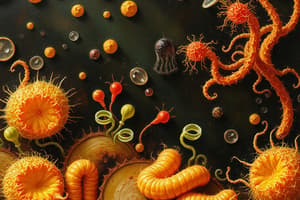Podcast
Questions and Answers
What is food science?
What is food science?
The study of the chemical, physical, and microbiological nature of foods and any transformation that food undergoes.
Which of the following is NOT an aspect of food quality?
Which of the following is NOT an aspect of food quality?
- Nutritional Quality
- Culinary Quality (correct)
- Sanitary Quality
- Digestibility
Food is any substance which when taken into the body provides energy, sustains life and builds and repairs ______.
Food is any substance which when taken into the body provides energy, sustains life and builds and repairs ______.
tissues
Which of these are considered macronutrients?
Which of these are considered macronutrients?
Sanitary quality refers to the contamination of food that is hazardous to human health.
Sanitary quality refers to the contamination of food that is hazardous to human health.
What are complete proteins?
What are complete proteins?
Which enzyme is used in cheese production?
Which enzyme is used in cheese production?
Name one undesirable reaction of enzymes in foods.
Name one undesirable reaction of enzymes in foods.
Most food is composed of organic compounds, primarily ______ and fats.
Most food is composed of organic compounds, primarily ______ and fats.
Which of the following components are classified as micronutrients?
Which of the following components are classified as micronutrients?
What is the most common dispersing medium in food?
What is the most common dispersing medium in food?
Flashcards are hidden until you start studying
Study Notes
Overview of Food Science
- Encompasses the chemical, physical, and microbiological properties of food.
- Studies transformations that affect food characteristics and properties.
Definition of Food
- Provides energy, sustains life, builds and repairs tissues.
- Regulates bodily processes, nourishes the body, and satisfies emotional needs.
Aspects of Food Quality
- Nutritional Quality: Involves nutrients categorized as water, carbohydrates, proteins, fats, vitamins, and minerals.
- Digestibility: Involves completeness of digestion, absorption, and the general aftereffects on well-being.
- Palatability: Evaluated by sensory experiences during consumption.
- Economy: Considers costs, time, equipment, and labor involved in food preparation and storage.
- Sanitary Quality: Must be free from contamination (microbiological, biological, chemical, physical, radiological) to prevent food-borne illnesses.
Food-Borne Illnesses
- Food Intoxication: Caused by toxins produced by pathogens.
- Food Infection: Result of consuming food contaminated with pathogens.
Chemical Composition of Food
- Macronutrients: Includes carbohydrates, proteins, fats, and water.
- Micronutrients: Comprised of vitamins and minerals.
- Non-nutritional Components: Incorporates pigments, enzymes, organic acids, and flavoring compounds.
Water in Food
- Most common dispersing medium and the most abundant compound in food.
- Exists in five forms: free water, hydrates, adsorbed water, absorbed in gels, and bound water.
Proteins
- Composed of amino acids linked by peptide bonds; essential for nutrition.
- Classification:
- Complete Proteins: Sources include meat, poultry, fish, dairy, and eggs.
- Incomplete Proteins: Primarily from plant sources (grains), excluding legumes.
Functions of Proteins in Food
- Hydration: Ability to form gels and absorb moisture.
- Denaturation: Alteration of protein structure through heat or pH changes.
- Enzymatic Reactions: Proteins facilitate various biochemical processes.
Useful Enzymes in Food Processing
- Rennin/Chymosin: Used in cheese production by converting milk to curd.
- Meat Tenderizers (e.g., Papain, Bromelain): Improve tenderness of meat.
- Pectinase and Amylase: Enhance fruit juice processing and bread-making by improving yield and fermentable sugars.
Undesirable Enzymatic Reactions
- Enzymatic Browning: Phenolic compounds react with oxygen leading to discoloration.
- Rancidity: Decomposition of fats and oils resulting in off-flavors and odors.
- Maturation and Spoilage: Enzymatic activity can lead to undesirable changes in vegetables and the decay of other food items.
Carbohydrates
- Synthesized through photosynthesis; essential as energy sources.
- Classified into two main groups: sugars and polysaccharides.
Studying That Suits You
Use AI to generate personalized quizzes and flashcards to suit your learning preferences.




